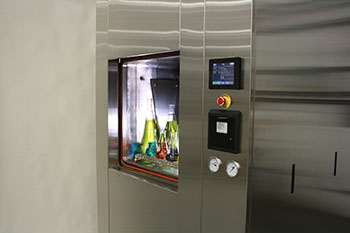The need to safely and quickly eliminate all microorganisms from equipment is our driver to choose the best sterilization method available. Although there are numerous physical and chemical processes used for proper sterilization of equipment, there are just a few main ones. With that said, there are three main types of sterilization methods common within the scientific community today. They are steam, dry heat, and ethylene oxide (EtO) sterilization. Understanding how each one of these works as well as their advantages and disadvantages is critical in helping make sound decisions on which method is ultimately best.
Types of Sterilization
Steam Sterilization

Steam sterilization (aka autoclaving) can be characterized as an effective, fast, safe, and affordable option for sterilization. An autoclave, which is a large steel chamber circulating steam, destroys microorganisms and bacterial spores via high temperatures and pressure. The steam needs to be maintained at approximately 120 degrees Celsius for a minimum of thirty minutes.
While there is a long list of benefits to autoclave sterilization, its non-toxicity and safety for humans are huge ones on the list. Not only can steam sterilization tout the ability to penetrate packaging and sterilize liquids, it also eliminates fire risks unlike dry heat. No doubt that the ability to rapidly sterilize equipment makes steam sterilization attractive to so many. It’s also one of the most economical and environment-friendly sterilization choices available. In addition, it’s known for being easy to control and monitor. Some disadvantages though include that it can’t sterilize heat/moisture sensitive material, has the potential to cause burns, and requires multiple utilities like water and electricity.
Dry Heat Sterilization
A thermal processing option commonly used is dry heat sterilization. This process removes moisture content from coatings and other materials. According to the CDC, this method should only be used “for materials that might be damaged by moist heat or that are impenetrable to moist heat (e.g., powders, petroleum products, sharp instruments).”
Let’s go over some of the benefits of using dry heat for sterilization. First, this non-toxic and environment-friendly option only requires electricity to operate. On top of that, it’s water-conservation friendly and has relatively low operating costs. In contrast, dry heat poses a fire risk and cannot sterilize liquids. Of particular note, dry heat is a very time-consuming sterilization process (4x to 5x longer cycles than steam sterilization). To elaborate on why it takes longer for sterilization with dry heat, it’s largely because of the issues of heating air with very little moisture content. What this means is that in order to accomplish proper dry heat sterilization, increased time and higher temperatures (approx. 180 degrees Celsius) are necessary.
Ethylene Oxide (EtO) Sterilization
Another commonly used way to sterilize equipment with gas is through EtO sterilization. The gas reacts in a way that disrupts cell growth and division, resulting in killing the microorganisms. This process occurs in a dry heat oven.
As for some of the pros to dry heat sterilization, it can be used for heat or moisture sensitive environments; be used on a variety of materials without distortion and functionality disruption; has the ability to penetrate packaging. Moreover, it requires only electricity and there’s cycle flexibility with single-dose cartridges. However, most obvious is the fact that EtO is toxic to humans and doesn’t rate high on the safety factor. Because of its toxicity, items need to be aerated prior to use which is quite time-consuming along with lengthy cycle times. The bottom line is that it’s a carcinogen and is flammable. One must be aware that EtO must be degraded before emission. In general, EtO sterilization is more complex than other methods as it does require multiple steps in the process for effective use.
Conclusion
Choosing a sterilization method is key critical for a variety of reasons. As we know, inappropriate sterilization can cause a lot of problems, with the worst scenarios involving fatalities. As you can see, there are advantages and disadvantages to each and what you are sterilizing becomes an important aspect to consider when making your selection. Based on the literature and research, if one stood apart from the others, it would easily be steam sterilization with its lengthy list of advantages. In conclusion, steam sterilization is a solid, all-around choice and it should be looked at as a first, go-to option for sterilization needs.


